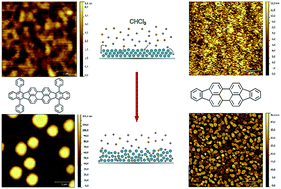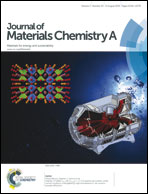Solvent vapor annealing on perylene-based organic solar cells†
Abstract
Diindenoperylene (DIP) and tetraphenyldibenzoperiflanthene (DBP) are two commonly used donor materials in organic solar cell devices. Despite their structural similarities, DIP films are crystalline, exhibiting good charge and exciton transport, whereas DBP films are amorphous and have lower carrier mobility and a short exciton diffusion length. However, DBP reveals a distinctly higher absorption due to the lying orientation of its transition dipole moments. In this paper, we investigate the influence of solvent vapor annealing (SVA) on the solar cell performance of both materials. In general, SVA induces a partial re-solubilization of the material leading to enhanced crystallinity of the treated layer. For DBP, extended annealing times result in a strong aggregation of the molecules, creating inhomogeneous layers unfavorable for solar cells. However, in DIP cells, SVA leads to an increase in fill factor (FF) and also a slight increase in short-circuit current density (JSC) due to interface roughening. The best results are obtained by combining solvent vapor annealed DIP layers with strongly absorbing DBP and C70 on top. Through this device architecture, we obtain the same increase in FF in addition to a higher gain in JSC, elevating the power conversion efficiency by a factor of 1.2 to more than 4%.


 Please wait while we load your content...
Please wait while we load your content...